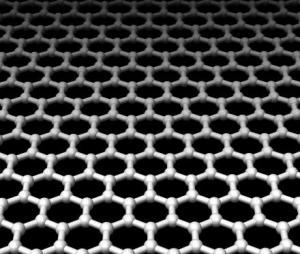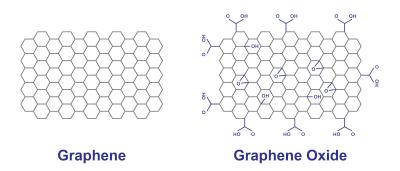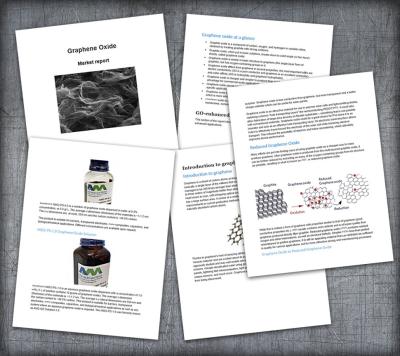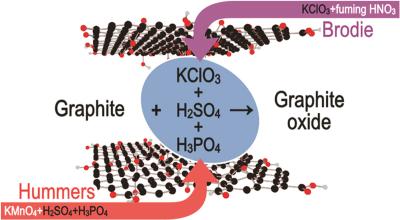What is Graphene Oxide?
Graphene is a material made of carbon atoms that are bonded together in a repeating pattern of hexagons. Graphene is so thin that it is considered two dimensional. Graphene is considered to be the strongest material in the world, as well as one of the most conductive to electricity and heat. Graphene has endless potential applications, in almost every industry (like electronics, medicine, aviation and much more).

As graphene is expensive and relatively hard to produce, great efforts are made to find effective yet inexpensive ways to make and use graphene derivatives or related materials. Graphene oxide (GO) is one of those materials - it is a single-atomic layered material, made by the powerful oxidation of graphite, which is cheap and abundant. Graphene oxide is an oxidized form of graphene, laced with oxygen-containing groups. It is considered easy to process since it is dispersible in water (and other solvents), and it can even be used to make graphene. Graphene oxide is not a good conductor, but processes exist to augment its properties. It is commonly sold in powder form, dispersed, or as a coating on substrates.

Graphene oxide is synthesized using four basic methods: Staudenmaier, Hofmann, Brodie and Hummers. Many variations of these methods exist, with improvements constantly being explored to achieve better results and cheaper processes. The effectiveness of an oxidation process is often evaluated by the carbon/oxygen ratios of the graphene oxide.
Graphene oxide uses
Graphene Oxide films can be deposited on essentially any substrate, and later converted into a conductor. This is why GO is especially fit for use in the production of transparent conductive films, like the ones used for flexible electronics, solar cells, chemical sensors and more. GO is even studied as a tin-oxide (ITO) replacement in batteries and touch screens.
Graphene Oxide has a high surface area, and so it can be fit for use as electrode material for batteries, capacitors and solar cells. Graphene Oxide is cheaper and easier to manufacture than graphene, and so may enter mass production and use sooner.
GO can easily be mixed with different polymers and other materials, and enhance properties of composite materials like tensile strength, elasticity, conductivity and more. In solid form, Graphene Oxide flakes attach one to another to form thin and stable flat structures that can be folded, wrinkled, and stretched. Such Graphene Oxide structures can be used for applications like hydrogen storage, ion conductors and nanofiltration membranes.
Graphene oxide is fluorescent, which makes it especially appropriate for various medical applications. bio-sensing and disease detection, drug-carriers and antibacterial materials are just some of the possibilities GO holds for the biomedical field.
Buy Graphene Oxide
Graphene oxide is relatively affordable and easy to find, with many companies that sell it. It does, however, get confusing since different companies offer products that vary in quality, price, form and more - making the choice of a specific product challenging. If you are interested in buying GO, contact Graphene-Info for advisement on the right GO for your exact needs!
Further reading
- Introduction to graphene
- Graphene company database
- Graphene batteries
- Graphene supercapacitors
- The Graphene Handbook, our very own guide to the graphene market
- Graphene Oxide Market Report
Graphene-Info releases a new edition of its Graphene Oxide Market Report
Today we published a new edition of our Graphene Oxide Market Report, with all the latest information, including new research activities related to GO. Our market report is a comprehensive guide to graphene oxide (and r-GO) materials and their promising applications in energy storage, composite materials, bio-medical, water treatment and more.
Reading this report, you'll learn all about:
- The difference between graphene oxide and graphene
- Graphene oxide properties
- Possible applications for graphene oxide
- Reduction of graphene oxide to r-GO
The report package also provides:
- A list of prominent GO research activities
- A list of all graphene oxide developers and their products
- Datasheets for over 20 different GO materials
- Free updates for a year
This Graphene Oxide market report provides a great introduction to graphene oxide materials and applications, and covers everything you need to know about GO materials on the market. This is a great guide for anyone interested in applying graphene oxide in their products.
NematiQ GO membrane receives WaterMark Certification
Australia-based NematiQ has announced that after more than a decade of work, the NematiQ Graphene Oxide membrane has obtained WaterMark certification, solidifying its status as a safe product for water filtration.
The Australian WaterMark Certification Scheme is a mandatory scheme for plumbing and drainage products of a certain type. Certification ensures products are fit for purpose and appropriately authorized for use in plumbing and drainage installations. The Australian Building Codes Board administers and manages the Scheme.
Researchers develop method to create stretchable and tough graphene films
Researchers have been working on creating elastic and tough graphene films, but it has proven quite challenging so far. Now, researchers at Shanghai Jiao Tong University have introduced a method to overcome this hurdle: they linked graphene nanolayers via "extendable" bridging structures.
Image credit: Angewandte Chemie
The special properties of graphene nanolayers often drop off when the layers are assembled into foils, because they are only held together by relatively weak interactions—primarily hydrogen bonds. Approaches that attempt to improve the mechanical properties of graphene foils by introducing stronger interactions have only been partially successful, leaving room for improvement in the stretchability and toughness of the materials. The research team, led by Xuzhou Yan at Shanghai Jiao Tong University in China, chose a new approach: they cross-linked graphene nanolayers with mechanically interlocked molecules whose building blocks are not chemically linked, but rather inseparably spatially entangled. The researchers used rotaxanes as their links.
Researchers develop graphene oxide spray coating for antiviral protection of face masks
Researchers at Spain's IMDEA Materials Institute, Rey Juan Carlos University and Valladolid University have developed a new spray coating to improve the antiviral efficacy of personal protective equipment, notably face masks.
The team's system is based on nanoplatelets of graphene oxide (GO) spray coated via a simple one-step procedure over a poly(lactic acid) textile fabric, allowing a homogeneous coating. The incorporation of GO does not affect the textile structure nor its air permeability, while it increases its water contact angle, potentially preventing droplet trespassing.
Researchers use graphene oxide to develop devices that could advance future cellular therapy for multiple sclerosis patients
A team from the National Hospital for Paraplegics (SESCAM), in collaboration with the Materials Science Institute of Madrid (ICMM-CSIC), has shown how new cell culture devices based on graphene oxide maintain the anti-inflammatory function of myeloid suppressor cells (MDSCs) once isolated from the donor's body. This function could be crucial for advancing cellular therapy beneficial to people with multiple sclerosis.
"To exert their inflammation-controlling function in diseases such as multiple sclerosis, myeloid suppressor cells must maintain a very immature state. However, when extracted from the bone marrow and cultured in the laboratory, they begin to mature, losing their immunosuppressive activity, rendering them unsuitable for potential cellular therapy for patients with this type of neurodegenerative disease," explains Diego Clemente, a researcher at the National Hospital for Paraplegics and one of the lead authors of the study.
First Graphene announces successful production of multi-kilogram quantities of graphene oxide
First Graphene has reported the successful production of multi-kilogram quantities of graphene oxide at the Company’s Henderson facility in Western Australia.
Building on existing manufacturing expertise, First Graphene identified a new route to manufacturing graphene oxide materials using the Company’s existing capabilities, opening an expanded range of commercial opportunities. The graphene oxide product was manufactured in a cost-effective, scalable, and repeatable process that produces a consistent product with minimal waste streams.
Graphene-Info releases a new edition of its Graphene Oxide Market Report
Today we published a new edition of our Graphene Oxide Market Report, with all the latest information, including new research activities related to GO. Our market report is a comprehensive guide to graphene oxide (and r-GO) materials and their promising applications in energy storage, composite materials, bio-medical, water treatment and more.
Reading this report, you'll learn all about:
- The difference between graphene oxide and graphene
- Graphene oxide properties
- Possible applications for graphene oxide
- Reduction of graphene oxide to r-GO
The report package also provides:
- A list of prominent GO research activities
- A list of all graphene oxide developers and their products
- Datasheets for over 20 different GO materials
- Free updates for a year
This Graphene Oxide market report provides a great introduction to graphene oxide materials and applications, and covers everything you need to know about GO materials on the market. This is a great guide for anyone interested in applying graphene oxide in their products.
Research develop new non-toxic method for producing high-quality graphene oxide
Researchers at Sweden's Umeå University, Lund University and Denmark's Aarhus University have reported a new way to synthesize graphene oxide, which has significantly fewer defects compared to materials produced by the most common method. To date, graphene oxide of similarly good quality could only be synthesized by using a rather dangerous method involving extremely toxic fuming nitric acid.
Graphene oxide is often used to produce graphene by removing oxygen. However, if there are holes in graphene oxide, there will also be holes after it is converted to graphene. Therefore, the quality of the graphene oxide is very important. Umeå University's Alexandr Talyzin and his research group have now addressed the issue of how to safely make good graphene oxide.
First-in-human testing of graphene's safety shows encouraging results
Researchers at the University of Manchester, University of Edinburgh, ICN2, RIVM and the University of the Highlands and Islands have tested the safety and health implications of graphene, revealing that it has the potential to be used without risk to human health.
The study has shown that the use of graphene without harm to the human body is possible, through the carefully controlled inhalation of graphene, shown to have no short-term adverse effects on cardiovascular function.
Researchers examine the use of graphene oxide to strengthen 3D-printed concrete
Researchers at Australia's RMIT University and University of Melbourne have investigated the effectiveness of graphene oxide (GO) sheets in enhancing the compressive strength of 3D-printed cementitious mortar.
They added graphene oxide to the cement used as a binder in 3D-printed concrete. After experimenting with different amounts, it was found that when graphene oxide was added at a dosage of 0.015% the weight of the cement, the resulting concrete exhibited better inter-layer bonding. This boost produced a 10% increase in overall strength.
Pagination
- Page 1
- Next page







